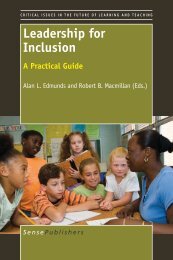1177-threshold-concepts-and-transformational-learning
1177-threshold-concepts-and-transformational-learning
1177-threshold-concepts-and-transformational-learning
- No tags were found...
You also want an ePaper? Increase the reach of your titles
YUMPU automatically turns print PDFs into web optimized ePapers that Google loves.
TRANSCENDING DISCIPLINARY BOUNDARIES[a clarity illuminates] relations of interdependence between considerations previouslyunorganized <strong>and</strong> disconnected ... binding isolated items into a coherent singlewhole (Dewey 1991 p. 80). Using Gurwitsch’s framework, the field of consciousnesschanges as a result of transformative <strong>learning</strong>: elements formerly not foundin any domain of consciousness, possibly including component parts of elementsformerly classified as nondecomposable, now occupy the thematic focus or residein the thematic field, <strong>and</strong> some elements formerly found there are now relegated tothe margin.The operation of reflectiveness corresponds to steps 2, 3, <strong>and</strong> 4 in Barer-Stein’sphenomenological analysis of <strong>learning</strong> as a five-step process of experiencing theunfamiliar: [ 1) ], being aware ... [characterized by the dominant question,] What isthis?; [ 2) ], observing ... How does this compare with what I know?; [ 3) ], acting ...Shall I try it?; [ 4) ], confronting ... Do I know this?, Do I want to?; [(if yes), then][ 5) ], involving ... How did this come to be?, What are the possibilities, <strong>and</strong> whichmakes sense?, What [meaning] is relevant for me? (Mezirow 1991 p. 84, Barer-Stein1987). As an example, consider the second possible response attributed to the traveler.The mechanism of reflectiveness is not well understood; it remains perhaps ...permanently inscrutable (Kuhn 1996 p. 90). It might be described briefly (<strong>and</strong>vaguely) as follows: Once explicitness forces the inadequacies – <strong>and</strong> the existence –of one’s meaning frame into (at least somewhat) conscious awareness, one engagesin some combination of conscious <strong>and</strong> unconscious (Dewey 1991 p. 217) examinationof the frame, to determine its inadequacies <strong>and</strong> correct them. The process isterminated by ... a relatively sudden ... unstructured event [experienced as] a gestaltswitch (Kuhn 1996 p. 122), corresponding to the newly reformulated meaningframe that is required in order to accommodate the (now formerly) troublesomeknowledge. The five-step sequence is thus compressed to: discontinuity reflectiveness new meaning frame, or (conforming more to case study coursestudent data): confusion struggle exp<strong>and</strong>ed knowing.Revisiting the TC / tc Central Question(s)In light of the proposed theoretical foundation, TC central question(s) can bereformulated.1+) from the TC practitioner teacher: How to ensure students’ reflective responseto an encounter with the existentially unfamiliar, educationally critical contentof the discipline?2+) from the TC describer scholar: How to describe students’ (reflective) responseto an encounter with the existentially unfamiliar, educationally critical contentof the discipline?3+) from the TC theoretician, (who is tasked with addressing epistemologicallyprior considerations (Gurwitsch 1974), which here means underst<strong>and</strong>ing howstudents actually do respond to such encounters <strong>and</strong> the mechanism(s) of theirresponses): What actually occurs in an encounter with the existentiallyunfamiliar, educationally critical content of the discipline? How does it lead – ornot – to <strong>learning</strong>?35




